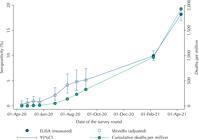ABSTRACT
OBJECTIVE
To describe the evolution of seropositivity in the State of Rio Grande do Sul, Brazil, through 10 consecutive surveys conducted between April 2020 and April 2021.
METHODS
Nine cities covering all regions of the State were studied, 500 households in each city. One resident in each household was randomly selected for testing. In survey rounds 1–8 we used the rapid WONDFO SARS-CoV-2 Antibody Test (Wondfo Biotech Co., Guangzhou, China). In rounds 9–10, we used a direct ELISA test that identifies IgG to the viral S protein (S-UFRJ). In terms of social distancing, individuals were asked three questions, from which we generated an exposure score using principal components analysis.
RESULTS
Antibody prevalence in early April 2020 was 0.07%, increasing to 10.0% in February 2021, and to 18.2% in April 2021. In round 10, self-reported whites showed the lowest seroprevalence (17.3%), while indigenous individuals presented the highest (44.4%). Seropositivity increased by 40% when comparing the most with the least exposed.
CONCLUSIONS
The proportion of the population already infected by SARS-Cov-2 in the state is still far from any perspective of herd immunity and the infection affects population groups in very different levels.
COVID-19, epidemiology; Seroepidemiologic Studies; Immunity, Herd; Socioeconomic Factors; Health Surveys

 Thumbnail
Thumbnail
 Thumbnail
Thumbnail
 Thumbnail
Thumbnail


